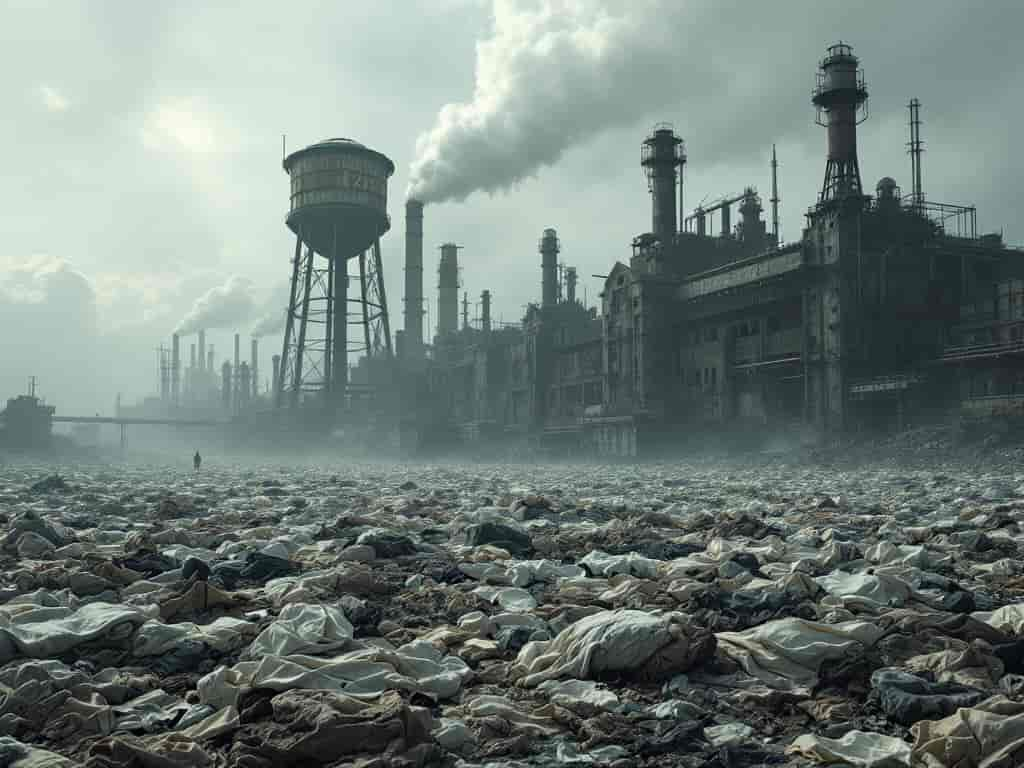Fast Fashion’s Impact on Our Planet
Ellie Moore

Photo: Fast Fashion’s Impact on Our Planet
Fast Fashion’s Impact on Our Planet: What You Need to Know
Fast fashion has become one of the most talked-about issues in today’s world of consumerism. While it's easy to get caught up in the allure of affordable, trendy clothing, the hidden costs of fast fashion are far from stylish. From environmental destruction to human rights abuses, the impact of the fast fashion industry on our planet is far-reaching.
In this article, we’ll explore the environmental consequences of fast fashion, its global implications, and most importantly, what we can do to reduce our ecological footprint and support a more sustainable future.
The Rise of Fast Fashion: A Brief Overview
Fast fashion refers to the rapid production of inexpensive clothing to meet the latest trends, often resulting in lower-quality garments that don’t last long. Retailers like Zara, H&M, and Shein are at the forefront of this trend, producing massive quantities of clothing that are quickly mass-marketed and consumed. While the appeal is undeniable affordable, stylish clothing available on demand there are grave environmental and social costs that most consumers are unaware of.
Why Is Fast Fashion So Popular?
The success of fast fashion lies in its ability to deliver the latest styles at breakneck speed. The industry capitalizes on two main factors:
- Affordability: By cutting corners on quality and labor costs, fast fashion brands can produce clothing at a fraction of the price of more sustainable fashion alternatives.
- Accessibility: With the rise of online shopping, consumers can now access new collections almost immediately. The speed with which clothing is produced and sold creates a sense of urgency forcing consumers to buy before the next trend comes along.
However, the ease of purchasing cheap clothes comes with significant consequences for the environment and society.
The Environmental Toll of Fast Fashion
The environmental consequences of fast fashion are severe. This industry is a major contributor to pollution, waste, and resource depletion. Let’s break down the key ways fast fashion harms our planet.
1. Massive Carbon Footprint
The fashion industry is responsible for approximately 10% of global carbon emissions, a staggering amount that rivals the emissions produced by international flights and shipping combined. This is mainly due to the energy-intensive nature of textile production, dyeing, and processing, which relies heavily on fossil fuels.
2. Water Consumption and Pollution
Water is a precious resource, yet the fashion industry is one of the largest water consumers globally. It takes about 2,700 liters of water to make a single cotton shirt. That's enough water for one person to drink for over two and a half years! On top of this, the dyes and chemicals used in textile manufacturing often end up in rivers, contributing to significant water pollution.
3. Toxic Waste and Chemical Use
Many fast fashion brands rely on synthetic fibers like polyester, which are derived from petroleum and take hundreds of years to decompose. These fibers release microplastics into the environment when washed, further polluting our oceans. Additionally, chemicals used in dyeing and finishing processes can leach into the soil and water, harming local ecosystems.
4. Textile Waste and Landfills
Fast fashion promotes a "wear once, discard" mentality, leading to mountains of textile waste. More than 92 million tons of textile waste are generated each year, and much of this ends up in landfills. Since synthetic fabrics are non-biodegradable, they can sit in landfills for centuries, contributing to soil and water pollution.
The Social Impact of Fast Fashion
While the environmental consequences are well-known, the human cost of fast fashion is just as alarming. The industry often exploits workers in developing countries, paying them meager wages for long hours in hazardous working conditions.
1. Labor Exploitation
Fast fashion brands frequently outsource their production to factories in countries where labor laws are weak or not enforced. Workers, including children, are often paid below the minimum wage and work in unsafe conditions. Many of these factories have poor ventilation, inadequate safety measures, and exploitative labor practices.
2. Impact on Local Communities
In countries where textile factories are concentrated, local communities often suffer from poor air quality, contaminated water, and a lack of adequate healthcare. Moreover, when these factories close or relocate to even cheaper regions, it leaves entire communities without stable employment, perpetuating the cycle of poverty.
The Need for Sustainable Fashion: A Path Forward
The harmful impact of fast fashion on the planet and people cannot be ignored. But there is hope consumers are increasingly becoming aware of these issues, and a shift toward more sustainable fashion is underway. Here are a few ways we can make a difference.
1. Choose Quality Over Quantity
One of the easiest ways to combat the fast fashion crisis is to invest in high-quality clothing that will last longer. Rather than buying multiple cheap items every season, focus on fewer, well-made pieces that can be worn for years. Look for clothes made from natural fibers like organic cotton, wool, and linen, which are more sustainable and biodegradable.
2. Support Sustainable Brands
Many fashion brands are now adopting eco-friendly practices. Brands such as Patagonia, Stella McCartney, and Reformation have committed to sustainable sourcing, fair labor practices, and minimizing their environmental impact. By supporting these companies, consumers can help shift the market toward sustainability.
3. Shop Secondhand
The secondhand clothing market has exploded in recent years, with platforms like Depop, Poshmark, and ThredUp offering an accessible way to buy and sell pre-owned clothing. Shopping secondhand not only reduces demand for new garments but also gives a second life to clothes that might otherwise end up in a landfill.
4. Recycle and Upcycle
Instead of throwing away old clothes, consider donating, recycling, or upcycling them. Many communities have clothing donation bins or local charities that can repurpose clothing. You can also try DIY projects to transform your old clothes into something new and unique.
5. Educate Yourself and Others
Raising awareness about the environmental and social costs of fast fashion is key to driving change. Share information with friends and family, and encourage them to make more informed purchasing decisions. The more people understand the implications of their buying habits, the greater the collective impact.
Real-Life Examples of Change
Several companies are setting a strong example of how the fashion industry can evolve into a more sustainable space:
- Patagonia: Known for its commitment to the environment, Patagonia uses recycled materials, donates 1% of its sales to environmental causes, and encourages customers to repair and reuse their clothing.
- Everlane: This brand focuses on transparency, showing customers the true cost of making their clothing and the environmental impact of each product.
- Allbirds: Allbirds produces shoes and apparel made from natural materials like merino wool and eucalyptus fiber, focusing on carbon neutrality and sustainability.
These brands prove that it is possible to combine fashion with environmental responsibility.
Conclusion: A Call to Action
Fast fashion has undeniable consequences for both our planet and the people who inhabit it. From the depletion of natural resources to the exploitation of workers, the impacts are far-reaching and urgent. However, by making conscious decisions as consumers, supporting sustainable brands, and reducing our own consumption, we can collectively help mitigate these issues.
We all have the power to create positive change whether it’s through buying less, supporting ethical brands, or educating others about the true costs of fast fashion. By making small shifts in our habits, we can start to rebuild a more sustainable, equitable, and conscious fashion industry for the future.
Frequently Asked Questions (FAQs)
1. What is the biggest environmental impact of fast fashion? The biggest environmental impact of fast fashion is its significant carbon footprint and water consumption. The textile industry is one of the top polluters in the world, contributing to air and water pollution, and deforestation.
2. How can I reduce my impact on the environment when shopping for clothes? Opt for high-quality, long-lasting garments, support sustainable brands, buy secondhand, and recycle or upcycle your old clothes. These steps can help reduce the demand for fast fashion.
3. Are there any eco-friendly fashion brands? Yes, brands like Patagonia, Everlane, and Reformation are known for their commitment to sustainability. These companies use eco-friendly materials, implement fair labor practices, and work to reduce their environmental footprint.
4. How much water does it take to make one t-shirt? It takes about 2,700 liters of water to produce a single cotton t-shirt enough water for one person to drink for two and a half years.
Call to Action: Have you ever considered the environmental impact of your clothing choices? Join the movement toward sustainable fashion by making informed decisions. Share your thoughts or explore more about how fashion can change for the better!
Finance & Investment
View All
February 7, 2025
Market Segmentation: Breaking Down the BasicsGet a simple yet comprehensive guide to understanding the basics of market segmentation and its importance for success.
Ellie Moore

February 23, 2025
Top Finance Jobs Hiring NowMaster "Expert SEO Content" to rank high & build trust. Learn to blend deep knowledge, E-E-A-T, and user intent for valuable, discoverable content.
Ellie Moore

October 5, 2025
Bajaj Finance Share Market UpdateMaster expert SEO content to build online authority, drive organic traffic, and establish your brand as a trusted leader. Go beyond keywords!
Ellie Moore

November 26, 2024
How to Avoid Common Retirement MistakesNavigate retirement planning with ease! Learn how to avoid common mistakes and pitfalls. Discover expert tips for a successful retirement journey. Start planning today!
Ellie Moore

May 1, 2025
Manufactured Home Financing HelpCraft expert SEO content to rank higher and attract your audience. Discover the blueprint for building authority, trust, and visibility with E-E-A-T focused con...
Ellie Moore

February 16, 2025
Capital One Auto Finance HelpMaster expert SEO content to rank higher and engage readers. Learn strategies for authority, user intent, and delivering exceptional value.
Ellie Moore
Insurance
View AllPolicyholders & risk managers: Secure premium insurance quotes for optimal coverage, maximum savings, and tailored protection.
Ellie Moore
Protect your finances with Liberty Mutual Car Insurance. Our comprehensive guide helps policyholders & risk managers optimize coverage & compare rates.
Ellie Moore
Discover how insurance policies have evolved over time to meet changing needs, from early models to modern-day coverage.
Ellie Moore
Secure lifelong financial stability with Complete Whole Life Insurance. Discover guaranteed growth, comprehensive protection, and accessible cash value for your...
Ellie Moore
Protect your assets! Secure optimal premium renters insurance coverage & peace of mind. Avoid financial loss with our comprehensive guide.
Ellie Moore
Don't settle for basic car insurance. Get a premium quote for superior, comprehensive coverage. Protect assets & ensure financial security for policyholders & r...
Ellie Moore
Education
View AllProviding education in conflict zones is a major challenge. Learn about the barriers and efforts to ensure learning continuity in crisis situations.
Read MoreArts education is key to fostering creativity. Learn why it’s important in schools and how it helps students develop essential life skills.
Read MoreOpen educational resources are breaking down barriers to knowledge. Learn how free learning materials are changing the global education scene.
Read MoreThe digital divide limits education access. Explore strategies and initiatives to bridge this gap and ensure global learning equality.
Read MoreExplore the ongoing debate on standardized testing. Learn its pros, cons, and whether it should remain a key part of education.
Read MoreSudbury schools embrace radical self-direction in learning. Learn how they empower students to take full control of their education journey.
Read MorePopular Post 🔥
View All
1
2
3
4
5
6
7
8
9
10
Health






Automotive
View All
July 30, 2025
Anything Automotive You Should Know Today
The automotive world is shifting! Learn about EVs, charging, and new tech to make smarter driving decisions for your wallet and the planet.

August 17, 2025
Automotive Record Player A Retro Ride Upgrade
Upgrade your ride with a retro automotive record player! Experience the warm, rich sound of in-car vinyl for a truly unique analog journey.

August 14, 2025
Are Brunt Boots Good For Automotive Work
Considering Brunt Boots for auto work? Discover if they meet the safety & comfort demands of mechanics, including EH, slip & toe protection.

August 29, 2025
Smoke Machine Automotive Uses And Benefits
Discover how automotive smoke machines revolutionize car repair! Easily find hidden leaks (vacuum, exhaust, EVAP) for precise fixes. Make the invisible visible!

February 8, 2025
Ride-Sharing’s Impact on Car Ownership Explained
Discover how ride-sharing services are changing car ownership. Learn about the economic and environmental effects of this evolving trend.

August 14, 2025
Top Apps For Automotive Needs And Repairs
Discover essential automotive apps for diagnostics, maintenance, navigation, and more. Enhance your car ownership with convenience, savings, and safety.

















